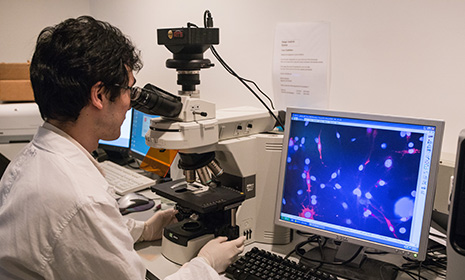Committee on the Use of Live Animals in Teaching and Research (CULATR)
The CULATR was established in 1980 by the University to advise teaching and research staff on matters concerning animal experimentation. The Committee has prepared guidelines for the use of experimental animals within the University. Currently it has a co-opted member from the Society for the Prevention of Cruelty to Animals. CULATR holds meeting at least twice a year and conducts bi-annual visits to all animal facilities in the University.
Protocols for all teaching and research experiments using live animals have to be scrutinised by the Committee beforehand. CULATR application forms and guidelines are available from https://www.med.hku.hk/en/Research/Ethics-and-Integrity/Animal-Ethics. All applications for CULATR approval should be typed/printed and prepared in the format of the application form designed by the Committee. Applicants should follow the Committee guidelines and provide answers to all the questions listed in the application form. This will facilitate the processing of their applications and minimize any unnecessary delay.


CULATR Membership (Please refer to the CULATR webpage)
CULATR home pageReference documents/ websites for completion of the CULATR Application Form
- CCAC Guidelines on the Care and Use of Wildlife, Canadian Council on Animal Care
- Center for Alternatives to Animal Testing (Altweb)
- Code of Practice for the housing and care of animals used in scientific procedures, 2014, Home Office, UK
- Fund for the Replacement of Animals in Medical Experiments (FRAME)
- Guidance on the housing and care of the African clawed frog Xenopus laevis
- Guidelines for the Use of Fishes in Research, American Fisheries Society
- International Guiding Principles for Biomedical Research Involving Animals, ICLAS and CIOMS
- National Centre for the Replacement, Refinement and Reduction of Animals in Research
- National Centre for the Replacement, Refinement and Reduction of Animals in Research: ARRIVE guidelines
- Norwegian Reference Centre for Laboratory Animal Science and Alternatives (NORINA)
- The Principles of Humane Experimental Technique, William M.S. Russell & Rex L. Burch (1959)
- 3Rs – Reduction (experimental design)
Section 7
- Experimental Design for Biologists (Cold Spring Harbour Laboratory Press, 2007) (available at Yu Chun Keung Medical Library: call number: M570.724 G54)
- Principles of Experimental Design for the Life Sciences (CRC Press, 1996) (available at Hing Wai Storage; call number: D610.72 S46)
- Statistics and Experimental Design for Toxicologists (Third Edition) (CRC Press, 1999) (available at Main Library; call number: 615. 900727 G123 s)
- Statistics for Experimenters: Design, Innovation, and Discovery (Second Edition) (John Wiley & Sons. Inc.) (available at Yu Chun Keung Medical Library: call number: M001.424 B78 s)
- The Design of Animal Experiments: Reducing the Use of Animals in Research through Better Experimental Design (RSM, 2002) (available at the Yu Chun Keung Medical Library; call number: M616.0273 D4)
Section 11
- AFCD Code of Practice for Care and Use of Animals for Experimental Purposes (2004)
English version
Chinese version - CCAC Guidelines on Antibody Production, Canadian Council on Animal Care
- Guide for the Care and Use of Laboratory Animals, NRC, USA
- Harmonisation of Animal Care and Use Guildlines, Science (2006)
- Home Office Guidance Note: Antibody production – Principles for protocols of minimal severity (2000)
- Home Office Guidance Note: Water and food restriction for scientific purposes (2003)
- ILAR Guidelines for the Care and Use of Mammals in Neuroscience and Behavioral Research (2003)
- Laboratory birds: refinements in husbandry and procedures (2001)
- NIH Guidelines for Ascitis Production in Mice (2007)
- NIH Guidelines for Research Involving Recombinant DNA Molecules (2002)
- NIH Guidelines for Survival Rodent Surgery, USA (2007)
- Refinement and reduction in production of genetically modified mice
- Refining procedures for the administration of substances
- Saphenous vein puncture for blood sampling of the mice
- Sub-mandibular bleeding of mice (2005)
- The UKCCCR guidelines for the welfare of animals in experimental neoplasia (1997)
- Veterinary Care for Laboratory Animals, Centre for Comparative Medicine Research, HKU
Section 11(c)
- Anaesthesia and analgesia in laboratory animals, D.F. Kohn et al (2008)
(available online via HKU Library: http://library.hku.hk/record=b4166538) - Formulary for laboratory animals, C.T. Hawk et al (2005)
(available at the Yu Chun Keung Medical Library; call number: M 636.089514 F72) - Guidelines for animal surgery in research and teaching, Am J Vet Res, 54, 1544-1559 (1993)
available at www.lib.hku.hk - Handbook of laboratory animal management and welfare, S. Wolfensohn et al (2003)
(available at the Main Library; call number: 636.0885 W855 h) - Laboratory animal anaesthesia, P. Flecknell (1996)
(available at HKU Library; call number: 636.0885 F5) - Pain and distress in laboratory rodents and lagomorphs, Laboratory Animals 28, 97-112 (1994)
- Pain management in animals. P. Flecknell & A. Waterman-Pearson (2000)
(available at the Yu Chun Keung Medical Library; call number: M 636.08960472 P1) - The assessment and alleviation of pain and distress in research animals (2007)
Section 11(e)
- CCAC guidelines on: choosing an appropriate endpoint in experiments using animals for research, teaching and testing (1998)
- Guidelines for the Assessment and Management of Pain in Rodents and Rabbits, ACLAM (2006)
- NIH Guidelines for Endpoints in Animal Study Proposals, USA (2007)
Section 11(j)
- AVMA Guidelines for the Euthanasia of Animals (2013 Edittion)
- NIH Guidelines for Euthanasia of Rodents Using Carbon Dioxide (2011)
- NIH Guidelines for the Euthanasia of Rodent Feti and Neonates (2011)
Section 11(k)



